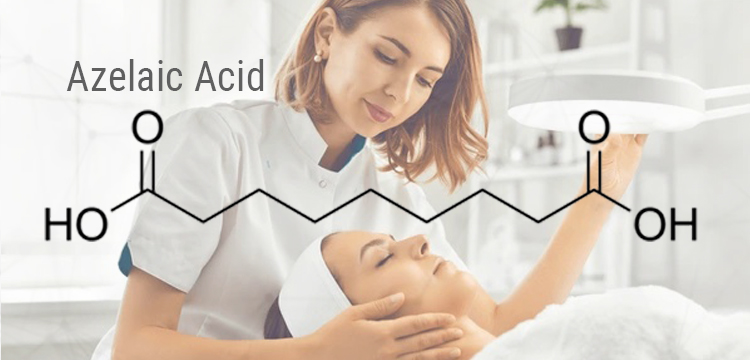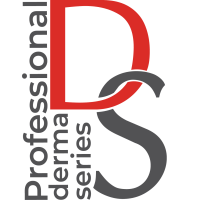Azelaic acid is normally formed in the human body during lipid metabolism on the skin as a result of the vital activity of resident microorganisms (it is formed by the oxidation of linoleic acid). This dicarboxylic acid is widely used in cosmetology and dermatology for: treatment of acne, rosacea, seborrheic dermatitis, correction of hyperpigmentation, treatment of androgenic alopecia, follicular keratosis.
PROPERTIES AND MECHANISM OF ACTION OF AZELAIC ACID
Azelaic acid is a highly effective and versatile ingredient with a wide spectrum of action:
- Anti-inflammatory action: it soothes the skin, reduces redness. Suppresses the activity of pro-inflammatory mediators (kallikrein-5).
It reduces the synthesis and secretion of the main pro-inflammatory cytokines (interleukins 1 and 8, tumor necrosis factor alpha) and antimicrobial peptides, blocking the activity of nuclear factor kappa B (nf-kb)
Azelaic acid stimulates the expression of the anti-inflammatory signaling molecule ppar-gamma (peroxisome proliferator-activated receptors — the receptor that activates the proliferation of peroxisomes), which reduces the release of cytokines and suppresses inflammation. - Antibacterial action: inhibiting the growth of Propionibacterium Acnes (P. Acnes) (the bacteria responsible for acne) and Staphylococcus epidermidis. The mechanism of antimicrobial action is based on the inhibition of the enzyme thioredoxin reductase of bacteria, which affects the inhibition of the synthesis of bacterial DNA that occurs in the cytoplasm
- Antiandrogenic effect: azelaic acid inhibits the synthesis of 5α-reductase type 1, which leads to a decrease in the content of dehydrotestosterone in sebocytes
- Keratolytic properties: azelaic acid exerts an antiproliferative cytostatic effect on keratinocytes, inhibits the maturation of keratinocytes by reducing the synthesis of keratin precursors. Contributes to reducing the thickness of the stratum corneum and reducing the number of keratohyalin granules by reducing the amount and distribution of filaggrin in the layers of the epidermis. Azelaic acid gently exfoliates, removes dead cells, prevents clogging of pores.
- Antioxidant properties: neutralizes reactive oxygen species (ROS), which are secreted by neutrophils, which leads to a decrease in both oxidative damage to tissues in places of inflammation and the formation of melanin.
- Depigmenting activity: azelaic acid helps to reduce skin pigmentation by affecting the enzyme systems of activated melanocytes. It slows down the formation of melanosomes, selectively affects abnormal melanocytes, and inhibits tyrosinase. It suppresses the activity of melanocytes (inhibits NADPH). The effectiveness of depigmentation is not inferior to 4% hydroquinone cream. It eliminates post-inflammatory hyperpigmentation.
Dicarboxylic acids do not affect normal skin melanocytes. Therefore, azelaic acid can be used to treat many skin hyperpigmentations and does not cause discoloration of healthy skin near the lesions. Suitable even for 4-5 skin phototypes.

BENEFITS OF AZELAIC ACID IN SKIN CARE
Azelaic acid does not have photosensitizing properties, does not have an aggressive effect on the skin, so it can be used for reactive and sensitive skin.
Given the low systemic bioavailability and low toxicity of azelaic acid, its use during pregnancy and lactation is possible (at the same time, additional consultation with an obstetrician-gynecologist is desirable). It is a safer alternative to other topical products such as retinoids, kojic acid, hydroquinone.
Azelaic acid is suitable for almost everyone, it is especially effective for oily and combination skin. In the treatment of acne, the side effects of azelaic acid are minimal compared to other traditional agents (benzoyl peroxide, salicylic acid, retinoids, antibiotics) and can be easily controlled by adjusting the concentration of azelaic acid in the cosmetic product.


Thus, azelaic acid has a number of advantages over alternative ingredients:
- minimal side effect
- low toxicity, does not have mutagenic and teratogenic properties
- possible use during pregnancy and lactation
- powerful antimicrobial action
- no photosensitizing properties
- the possibility of effective use for the treatment of rosacea
- reduction of pigmentation
- effective with long-term use, non-addictive
POSSIBLE SIDE EFFECTS OF AZELAIC ACID IN COSMETICS
patients, it’s suitable for sensitive skin and is used in the treatment of rosacea. However, its exfoliating properties can cause dryness and irritation when applied to patients with very sensitive skin or those who suffer from eczema. In this case, it is recommended to introduce products with azelaic acid gradually, to limit its use with the simultaneous use of other active ingredients, such as retinoids.
CONCENTRATION OF AZELAIC ACID IN COSMETICS
The European Union considers azelaic acid as a cosmetic ingredient that can be used without concentration restrictions. In the US, azelaic acid is approved for the treatment of acne (and rosacea).
Most often, the concentration of azelaic acid in cosmetics varies from 5% to 20%.
Azelaic acid can have a positive effect on the skin when it is included in cosmetic products in small concentrations of 3–10%. It is generally well tolerated even at very high percentages (20–25%) and can be used for a long time.
At a 20% concentration, azelaic acid has a pronounced whitening effect. At the same time, it should be taken into account that products with azelaic acid in a concentration of more than 10% have a higher risk of skin irritation.
COMBINATION OF AZELAIC ACID WITH OTHER ACTIVE COMPONENTS
Due to its versatility, azelaic acid works well in combination with other components:
Salicylic acid has keratolytic, sebum-regulating, antibacterial, and anti-inflammatory properties. The combination with azelaic acid is effective in acne treatment protocols. It ensures the normalization of sebaceous glands, correction of hyperkeratosis, improves skin microrelief, promotes renewal of keratinocytes. Since salicylic acid, like azelaic acid, does not have a photosensitizing effect on melanocytes, such a combination can be used in procedures regardless of seasons.
Niacinamide is a powerful regulator of cellular metabolism. It acts as an antioxidant, and helps reduce inflammation. The combination with azelaic acid is effective against hyperpigmentation and in the battle against acne and post-acne, improving skin elasticity.
Sulfur + azelaic acid is an effective combination in the treatment of acne and rosacea. It helps reduce redness, inflammation. The Sebo-Norm Mask harnesses the power of green clay, enriched with a blend of azelaic acid, sulfur, camphor, and plant extracts, to deliver therapeutic care for problematic skin. This unique formulation offers an array of benefits, including absorbent properties, anti-inflammatory action, vasoactive effects, soothing capabilities, pore tightening, and mattifying properties, resulting in clearer and healthier-looking skin.
With regular use, it provides prevention of demodex.
Hexylresorcinol potentiates the effect of acids, blocking the synthesis of melanin. The combination with azelaic acid provides a brightening effect.
Kojic acid is a mild inhibitor of tyrosinase, has an antibacterial, keratolytic effect. In combination with azelaic acid, it can be effectively used in hyperpigmentation correction programs.
Glycine soothes the skin, reduces redness, and moisturizes the skin.
Potassium Azeloyl Diglycinate is a biologically active complex that has the properties of azelaic acid and the amino acid glycine:
- Anti-inflammatory effect (blocks 5-alpha-reductase, suppresses activity of sebaceous glands)
- Antioxidant action (neutralizes free radicals, prevents the formation of reactive oxygen species in neutrophils)
- Inhibits tyrosinase (reduces melanin synthesis, corrects hyperpigmentation of any origin)
- Keratolytic action (restores normal differentiation of cells in the epidermis, evens out the microrelief).
This combination, together with niacinamide, hexylresorcinol, salicylic acid, is part of 4-Synergy Brightening Cream, which is recommended for the complex treatment of acne and rosacea, for the correction of hyperpigmentation of various origin.
Glycolic acid has a small molecular weight, thereby contributing to penetration into the deep layers of the skin, where it retains moisture, additionally moisturizing the skin. It has keratolytic, antibacterial, brightening and collagen stimulating properties. In combination with azelaic acid, it provides restructuring of the skin, such a combination is ideal for the correction and prevention of photoaging processes.
Retinoids bind to the nuclear receptors of each skin cell, normalizing their differentiation. The renewal of skin cells leads to an improvement in color and texture, tightens the dermis, increases turgor and tissue tone. A combination of retinoids and azelaic acid can help fight acne and post-acne. Both components in synergy correct hyperpigmentation of any origin.

4-SYNERGY BRIGHTENING CREAM – HOW TO USE IT? (IN QUESTIONS AND ANSWERS)
How many times a day?
Once in the evening, and to enhance the effect, you can do it twice a day. And if the UV index is higher than 3, then SPF protection in the morning is mandatory.
At what age is it appropriate to start using azelaic acid cream?
We focus on clinical indications, there are no age restrictions
Is it addictive?
No, there is only psychological addiction, when the result is already there, and you want even more.
Should the cream with azelaic acid be used as a course?
The minimum recommended course is 3 months, although it can be used continuously as needed.
Is it safe to use the cream alongside systemic retinoids?
At the beginning of the course, it is permissible to use azelaic acid for 1-2 months, then it should be replaced with products that moisturize the skin more and restore its lipid balance.
Which serums can be “closed” with a cream?
Absolutely all serums from the reNeo cosmetics range! And even a serum with retinol. But in the case of retinol, pay attention to the current condition of the skin, it is important not to overdo it.
Is it possible to use azelaic acid cream after peels?
We always finish the peel procedure with SPF creams. But for home care, we safely prescribe a cream with azelaic acid.
Is it possible to use the cream in the deep pore cleansing procedure?
Yes, it will provide an additional antiseptic effect, reducing the risk of rashes after the procedure.
What is better NOT to combine the cream with to prevent unwanted manifestations?
The form and concentration of azelaic acid exclude all undesirable manifestations. The maximum is a slight tingling for 1 minute during application of the product, which is the norm



